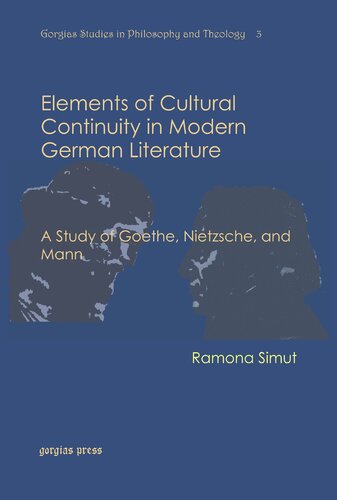

Most ebook files are in PDF format, so you can easily read them using various software such as Foxit Reader or directly on the Google Chrome browser.
Some ebook files are released by publishers in other formats such as .awz, .mobi, .epub, .fb2, etc. You may need to install specific software to read these formats on mobile/PC, such as Calibre.
Please read the tutorial at this link. https://ebooknice.com/page/post?id=faq
We offer FREE conversion to the popular formats you request; however, this may take some time. Therefore, right after payment, please email us, and we will try to provide the service as quickly as possible.
For some exceptional file formats or broken links (if any), please refrain from opening any disputes. Instead, email us first, and we will try to assist within a maximum of 6 hours.
EbookNice Team

Status:
Available4.5
9 reviews
ISBN 10: 1611439663
ISBN 13: 978-1611439663
Author: Ramona Simut
This book is a survey of the inner relationship between the most representative German writers and thinkers of the eighteenth, nineteenth, and twentieth century: Goethe, Nietzsche, and Thomas Mann, which examines the content of their thought as reflected in their attitude towards the arts, society, and politics of their times. Consequently, it is, on the one hand, a synoptic study, as it envisages the historical context of these three pivotal centuries and their strategic importance for the cultural and social development of modern Germany and Europe in general. On the other hand though, it provides a detailed analysis of the key aspects in the thought of Goethe, Nietzsche, and Thomas Mann, which led to the formation of common themes and concepts in their works and thus to the distinctive message they convey. The main purpose of the study is to prove that these common themes the condition and role of the artist in society, the non-exclusivity of art as related to politics, the need to transcend chaotic nationalist politics, etc. are in fact specific features of a direct Goethean heritage in the thought of both Nietzsche and Mann. This fact has two implicit conclusions. First, their message for society was ethical and visionary, representing the goal of their literary-philosophical productions. They were all searching for the meaning of the internal and external events in their lives and for the manifested opinions towards political turning points such as the French Revolution, Bismarck s Kulturkampf or the two world wars. Secondly, their ethical convictions are relevant to this day, as an increasing number of historians and literary critics try to find in the works of Goethe, Nietzsche, and Thomas Mann what can be defined as an answer to current inquiries which are similar to the ones in the past. After all, the art of writing is an art with a message.
Introduction
Johann Wolfgang von Goethe and the Cultural Configuration of the Eighteenth Century
Goethe and Naturalism: Science as a Passion of His Age
Goethe and Kantianism: Transcending the Reason of His Age
The Relationship between Nature and Art in Kant and Goethe
Goethe and Neo-Humanism: A Classic against His Age
Goethe between Wetzlar and Weimar: Escape and Return to Cultural Places
Goethe and German Culture: Preliminaries to Identity
German Culture and French Civilization in Goethe’s Time
Germany’s Freedom and Unity: Goethe’s Concept of National Identity
German Culture as a “Substitute”? Goethe’s View of Politics
Goethe between Literature and Music: Tempering the Heroic Ideals of His Age
Friedrich Wilhelm Nietzsche and the Crisis of Modern Culture in the Nineteenth Century
Nietzsche between His Life and Works
Nietzsche between Philosophy and Modern Music
Nietzsche and the False Nietzsche of Posterity
Nietzsche and The Will to Power: Gods against Modern Morality
elements of cultural continuity
cultural infusion explore the elements of continuity and change
what ensures the continuity of culture elements
cultural continuity definition
what are the five elements of cultural competence
Tags: Ramona Simut, Elements of Cultural, Continuity in Modern, German Literature